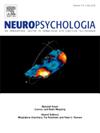Attentional modulation of peripheral pointing hypometria in healthy participants: An insight into optic ataxia?
IF 2
3区 心理学
Q3 BEHAVIORAL SCIENCES
引用次数: 0
Abstract
Damage to the superior parietal lobule and intraparietal sulcus (SPL-IPS) causes optic ataxia (OA), characterized by pathological gaze-centered hypometric pointing to targets in the affected peripheral visual field. The SPL-IPS is also involved in covert attention. Here, we investigated the possible link between attention and action. This study investigated the effect of attention on pointing performance in healthy participants and two OA patients.
In invalid trials, targets appeared unpredictably across different visual fields and eccentricities. Valid trials involved cued targets at specific locations. The first experiment used a central cue with 75% validity, the second used a peripheral cue with 50% validity. The effect of attention on pointing variability (noise) or time was expected as a confirmation of cueing efficiency. Critically, if OA reflects an attentional deficit, then healthy participants, in the invalid condition (without attention), were expected to produce the gaze-centered hypometric pointing bias characteristic of OA.
Results
revealed main effects of validity on pointing biases in all participants with central predictive cueing, but not with peripheral low predictive cueing. This suggests that the typical underestimation of visual eccentricity in OA (visual field effect) at least partially results from impaired endogenous attention orientation toward the affected visual field.
健康受试者外周指向性低血压的注意调节:对视神经共济失调的洞察?
顶叶上小叶和顶叶内沟(spll - ips)损伤可引起视性共济失调(OA),其特征是病理性凝视中心低测量指向受影响的周围视野中的目标。spll - ips也参与了隐蔽注意。在这里,我们调查了注意力和行动之间可能存在的联系。本研究探讨了注意对健康受试者和2例OA患者指指行为的影响。在无效的试验中,目标出现在不同的视野和怪癖中是不可预测的。有效的试验涉及特定地点的线索目标。第一个实验使用75%效度的中心线索,第二个实验使用50%效度的外围线索。注意对指向变异性(噪声)或时间的影响被期望作为提示效率的确认。关键的是,如果OA反映了注意力缺陷,那么健康的参与者,在无效条件下(没有注意力),预计会产生OA特征的以凝视为中心的低测量指向偏倚。结果:在所有被试中,中心预测线索对指向偏倚的效度有主要影响,而外围低预测线索对指向偏倚没有主要影响。这表明OA(视野效应)对视觉偏心率的典型低估至少部分是由于对受影响视野的内源性注意定向受损。
本文章由计算机程序翻译,如有差异,请以英文原文为准。
求助全文
约1分钟内获得全文
求助全文
来源期刊

Neuropsychologia
医学-行为科学
CiteScore
5.10
自引率
3.80%
发文量
228
审稿时长
4 months
期刊介绍:
Neuropsychologia is an international interdisciplinary journal devoted to experimental and theoretical contributions that advance understanding of human cognition and behavior from a neuroscience perspective. The journal will consider for publication studies that link brain function with cognitive processes, including attention and awareness, action and motor control, executive functions and cognitive control, memory, language, and emotion and social cognition.
 求助内容:
求助内容: 应助结果提醒方式:
应助结果提醒方式:


